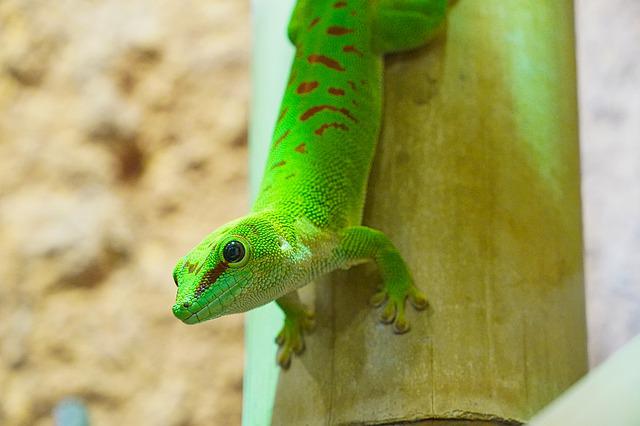What do Madagascar giant day geckos eat? This is a question that many people have, and it’s a valid one. These geckos are exciting creatures, and their diets are just as fascinating as they are. This blog post will take a closer look at what these geckos eat and explore some of the different food options available to them.
What do Madagascar giant day geckos eat?
1. Crickets: Madagascar giant day geckos will readily eat crickets of all sizes. In the wild, they typically eat small to medium-sized insects. However, in captivity, they will consume more giant insects like jumbo mealworms and Superworms.
2. Fruit: In addition to insects, Madagascar giant day geckos are also fond of fruit. They will often eat papayas, mangoes, and other sweet fruits. Some people even feed them diced bananas or apples as a treat.
3. Leafy greens: While not as popular as crickets or fruit, leafy greens should also be included in a Madagascar giant day gecko’s diet. Spinach, kale, and collard greens are all excellent choices.
4. Commercial diets: If you don’t have time to feed your gecko live food or chop up fresh fruits and vegetables, commercial diets can provide everything they need. Just be sure to choose a product formulated for day geckos specifically.
The different food options are available to Madagascar Giant Day Geckos.
In the wild, these geckos feed primarily on insects, but they are adaptable and will also eat fruit, flowers, and nectar.
When kept as pets, however, Madagascar Giant Day Geckos should be fed a diet that resembles their natural diet.
This means providing them with live or frozen insects like crickets or mealworms. Some pet stores also sell prepared diets specific to Madagascar Giant Day Geckos. These diets typically contain a mixture of insects, fruits, and vegetables.
While not required, offering your gecko various food items will help keep them healthy and encourage them to eat.
Why their diet is important
The Madagascar Giant Day Gecko’s diet is essential for several reasons.
- First, these geckos are obligate carnivores, requiring animal protein to survive. In the wild, they eat various insects, including crickets, moths, and beetles. They can be fed a commercially available insectivore diet or live insects in captivity.
- Second, their diet helps to keep their skin healthy. The high levels of protein and fat in their diet help maintain their skin’s integrity and prevent dehydration.
- Third, their diet gives them the energy they need to power their metabolism and maintain their body temperature.
- Fourth, the nutrients in their diet help to support their immune system and keep them healthy.
- Fifth, their diet helps them to stay hydrated. Their diet’s water content helps prevent dehydration and keeps them hydrated.
- Sixth, their diet helps them to grow and reproduce. The nutrients in their diet help to support growth and reproduction.
- Seventh, their diet helps them to thermoregulate. The nutrients in their diet help to regulate body temperature.
- Eighth, their diet helps them to maintain muscle mass. The proteins in their diet help to maintain muscle mass.
- Ninth, their diet helps them to detoxify. The nutrients in their diets help to remove toxins from their bodies.
- Tenth, the insects they eat provide them with essential vitamins and minerals they would not otherwise get from a captive diet. Insects are a natural source of vitamins A, B, C, and D, as well as calcium, phosphorus, and iron.
How Madagascar giant day geckos’ diet affects their behavior.
The way that giant day geckos in Madagascar diet affect their behavior.
These lizards are typically found near streams or other water sources, and they eat various insects, including moths, crickets, and grasshoppers.
However, research has shown that the type of food they eat can significantly impact their behavior.
For example, lizards that eat more moths are more likely to be active during the day, while those that consume more crickets are more likely to be involved at night. The difference in diet also affects how the lizards use their coloration to camouflage themselves.
Geckos that eat more moths have brighter colors, while those that consume more crickets tend to be darker. This difference in coloration makes it easier for predators to spot the lizards, but it also makes it easier for the lizards to find food.
As a result, the type of food a lizard eats can significantly impact its behavior and ability to survive in the wild.




